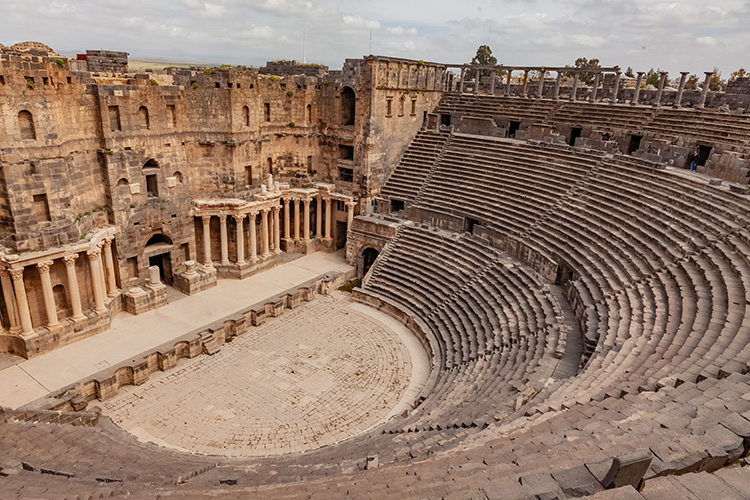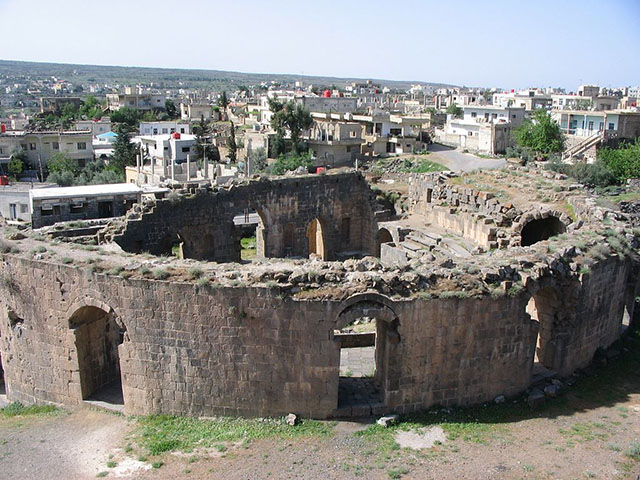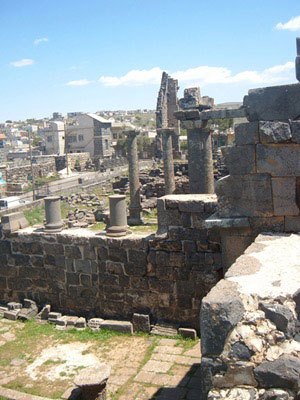Situated in the vast Hawran plain, about 145 klm south of Damascus. It is an extremely ancient city mentioned in the lists of Tutmose III and Akhenaten in the fourteenth century B.C.

The first Nabatean city in the second century B.C., it bore the name Buhora, but during the Hellenistic period, it was known by the name of Busra. Later the Romans took an active interest in the city, and at the time of the Emperor Trajan it was made the capital of the Province of Arabia (in 106 B.C.) and was called Neatrajana Busra.
The city saw its greatest period of prosperity and expansion then, became a crossroads on the caravan routes and the official seat and residence of the Imperial Legate.
After the decline of the Roman Empire, Bosra played a significant role in the history of early Christianity. It was also Iinked to the rise of Islam, when a Nestorian monk called Bahira, who lived in the city, met the young Muhammad when his caravan stopped at Bosra, and predicted his prophetic vocation and the faith he was going to initiate .
The oldest Islamic square minarets (still standing) are found in Bosra, whose prosperous role as an important halt for pilgrims on the way to Mecca lasted until the 17th century.
The most interesting part of the city today is the famous Roman theatre built in the second century A.D., which seats 15 thousand spectators, and is considered one of the most beautiful and well-preserved of Roman amphitheatres in the world. The stage is 45 meters long and 8 meters deep.
Every summer, it hosts Arab and international performers who entertain audiences during the Bosra Art Festival against a majestic background of Roman columns and arches.
The city itself contains a great number of Roman ruins, a part of the Byzantine Bahira Church, as well as the al-Mabrak Mosque, which is said to have been erected on the site where the Prophet’s camel stopped to rest.
There is also the Omar Mosque (also called the al-Arouss Mosque ) , which is the only one of its type remaining from the early days of Islam , and it retains its 7th century primitive form. An important Muslim citadel, dating back to the Ayoubite and Mamluk period still stands, and one of its towers now houses a museum of Antiquities and Traditional Arts.
In addition, the city also has:
– Remains of walls (Nabatean)
– A triumphal arch (Roman, 3rd century)
– Baths (Roman, 2nd century)
– Al Birkeh (a huge pool: 155 by 122 metres) (Nabatean)
– A Nabatean temple dating back to the first century
– A cathedral (Byzantine, 4th century).
CITIES AROUND BOSRA
SHAHBA ( PHILIPAPOLIS ) :
The ancient Philipopolis founded by Philip the arab 232-237 A.D, famous for its theatre, Tetrapyle and the ancient Roman baths and the mosaic museum.

QANAWAT :
Founded in the first century BC, Qanawat was the subject of struggle between Anthony and Herod the Great , the first wishing to restore the area to Cleopatra kingdom. Christianity flourished in the 4th and 5th centuries and it became the seat of a bishop. The visit includes what is popularly called “Seraya” including 2 buildings grouped around an atrium. These buildings were re-orientated to be adapted to the Christian worship where the altar is in the eastern part of the church. Visitors will admire the stonework decoration made in classical masonry.
Some of the most notable ruins of Qanawat include a Roman bridge and a theater hewn entirely from rock. The theater has nine rows of seats and an orchestra pit whose diameter measures 62 feet. Other sites that must not be missed are an aqueduct , a nymphaeum ( a monument dedicated to the nymphs), a large pro style temple featuring a portico and colonnades, and a peripheral temple with a magnificent double colonnade consecrated to Helios, the sun god. Perhaps the most remarkable sight to see in Qanawat is Es-Serai, a monument that dates back to around the 2nd century AD.
The monument was originally a temple but was converted into a Christian basilica in the 4th and 5th centuries.

Qanawat also has other temples dedicated to the god of water and to Athena Al Lat, which date back to the 3rd and 2nd centuries respectively.
Apart from these monuments mentioned above, the city also features several Roman and Byzantine tombs as well as public baths.


